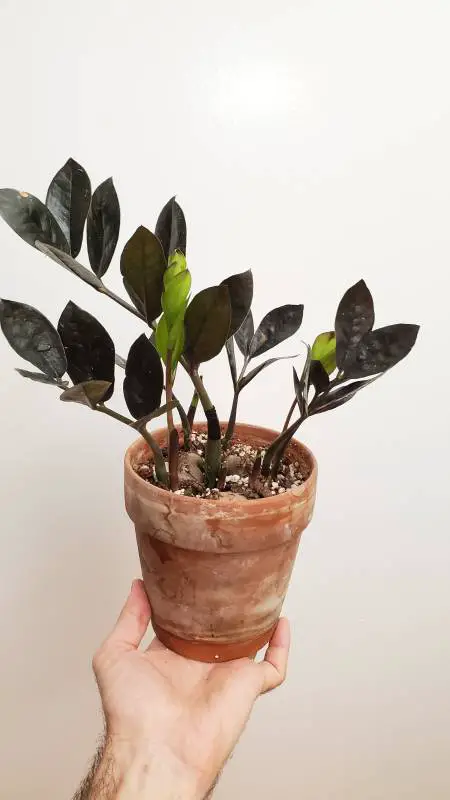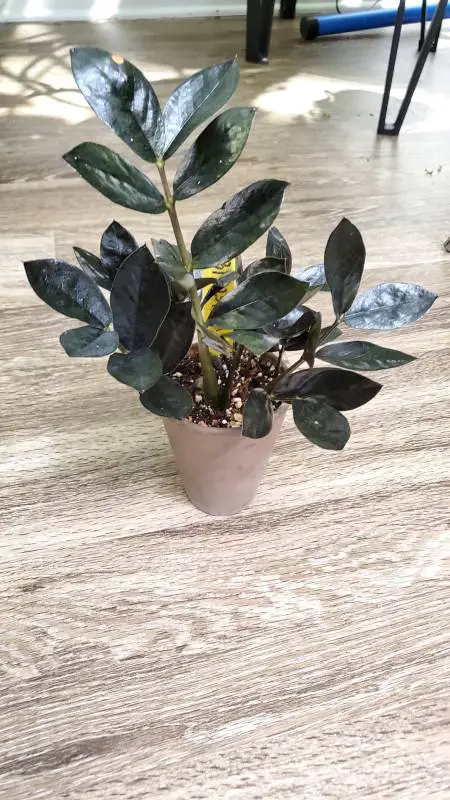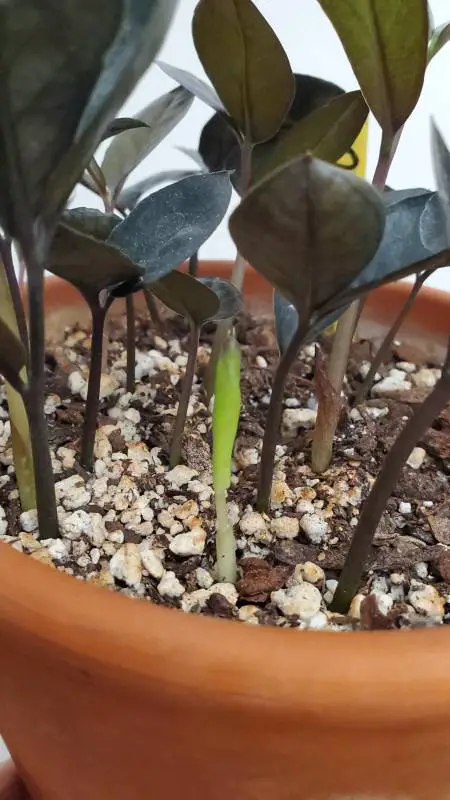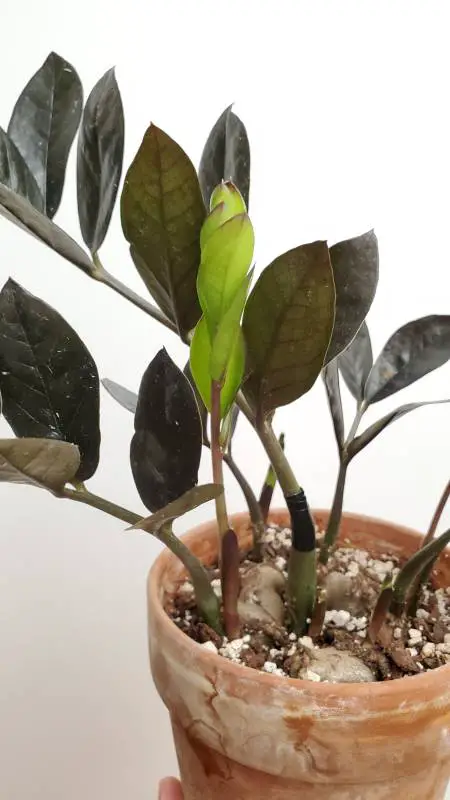
This ZZ Raven care guide covers everything from light requirements, watering, and fertilization to repotting and pruning your ZZ Raven plant. If you are unsure what is the best humidity and temperatures, we cover that and much more in this article.
| Botanical Name (Latin Name/Scientific Name): | Zamioculcas Zamiifolia Raven |
| Common Name: | ZZ Raven |
| Light: | low light tolerant (50 lux – 750+ lux) |
| Watering: | when the soil dries out to the bottom of the pot |
| Soil: | succulent or cacti mix |
| Repotting: | once a year |
| Temperature: | 18°C to 27°C (65° to 80°F) |
| Humidity: | 50% to 95% but adapts well to any humidity |
| Toxicity for Pets: | Yes (irritation of the mouth, tongue, and lips, drooling, vomiting, and difficulty swallowing) |
| Toxicity for Humans: | Yes (lips, mouth, tongue, and throat burning and swelling, contact dermatitis) |
| Propagation: |
|
| Pruning: | Prune dead or diseased growth or when you want the plant to branch out |
Light Requirements
| Minimal amount of light: | 50 Lux (5 FC) |
| Optimal amount of light: | 750+ lux (75+ FC) |
| Direct sun tolerance: | 3-4 hours |
| Category: | low light tolerant |
One of the ZZ Raven’s features that makes it so popular is its low light requirement. This plant tolerates extremely low light: 100 lux is a minimal requirement. However, at such low light, the stems will grow into long, leggy, and droopy ones. That said, for optimal growth, your ZZ Raven plant should be exposed to bright light (over 3000 lux). Being such a resilient plant, it can even tolerate a few hours of direct sun ( primarily during early morning and late afternoon). Bear in mind that although ZZ Raven can stand the direct sun, it isn’t a full sun plant.

Mr. Houseplant’s ZZ Raven with young new stems
Water Needs
Raven ZZ ‘s water requirements are the same as for its cousin, regular ZZ. Just like camels store the water supply in their humps, Raven ZZ stores water in its potato-shaped tubers.
This ability to go without water for a long period of time, even up to 4 months is what makes this plant so remarkable! This doesn’t come as a surprise since it originates from dry Africa. Taking this into account, you need to make sure not to overwater your Raven ZZ. In this case, less is more. To be more clear, it isn’t the amount of water but how long the soil remains wet. Why? If the soil remains wet for too long, it can cause root rotting.
A good rule of thumb is that you treat your Raven ZZ as a succulent and give it water when the soil is completely dry from top to bottom. It isn’t good to have a precise watering schedule because each environment is different, but I generally water my Raven ZZ every two weeks- when I am really sure that the soil is thoroughly and completely dry.
Humidity Needs
The preferred humidity level for ZZ Raven is between 50% and 95%. But like most houseplants, it adapts well to low humidity and will grow just fine even in homes with low humidity
Temperature Requirements
ZZ Raven thrives best at temperatures between 18°C and 27°C (65° to 80°F), but the plant can tolerate as low as 15C, below which it will slow down growth and can get damaged.
Fertilizing
If you repot your ZZ annually, there is no need to fertilize it. This once-a-year repotting provides fresh soil full of new nutrients. However, if you still want to fertilize your plant, then make sure that you do it during its growing season. If you fertilize your Raven ZZ when it stops growing, you risk oversaturating the soil with fertilizers, which will subsequently lead to nutrients accumulating over the course of time. As the end result, they can burn the roots, damage, or even kill your plant.
In case you would like to fertilize during the growing season, my choice would then be Espoma Succulent and Cacti Fertilizer.
Soil
When it comes to the soil mix, it should be the same as for regular ZZ, or in other words, the same as for other succulents. I use a well-draining chunky airy mix of peat moss, perlite, and bark. The main reason I prefer chunky mixes is that these large chunks create macropores, which have oxygen. Oxygen is essential for healthy roots and it reduces the chances of root rot. Furthermore, it decreases the chance of soil compaction (the more compact your soil becomes, the less oxygen it has; the less oxygen it has, the higher the chance of root rot).
I use 2 parts peat moss-based potting mix, 1 part perlite and 1 part bark. If you find this too much of a hassle and you want a ready-made solution, you can use this Succulent & Cacti Mix. A little tip: I also use terracotta pots so the mix can dry out faster.
Repotting
I already talked about the best soil for your Raven ZZ and why I like using terracotta pots. Let’s also check how to properly repot your plant so it gets the ultimate care.

Zamioculcas Zamiifolia Raven
Repotting refers to the removal of all soil or part of the soil, as well as the pruning of defective roots. The rules for repotting Raven ZZ are identical to the ones for ZZ:
- Prepare your potting mix
- Choose an appropriate pot (always take one size bigger than the previous one)
- Take the plant out, lightly loosen the rootball. If the roots are dying or diseased (soft and mushy), trim them.
- Fill ⅓ of the new pot with the potting mix, put the plant in and fill the pot up with the remaining mix
- Press well around the plant; it will help the soil settle down.
The video below shows how I repotted ZZ, but as I said, the rules are the same:
Another interesting thing you will see there is how peat moss repels water when it gets dry. Check the video to find out what to do when this happens.
A word of advice: since it is more delicate than regular potting up, I would suggest full repotting to more experienced plant parents.
Toxicity To Humans
Raven ZZ Plant is toxic to humans. Children’s Health Queensland Hospital and Health Service confirms that every part of the plant is poisonous if ingested. It can cause burning and pain, swollen lips, mouth, throat, and tongue.
Toxicity To Pets
Raven ZZ Plant is toxic to pets, according to the American Society For The Prevention Of Cruelty To Animals (ASPCA). This plant belongs to the Araceae family and contains calcium oxalates, so if your pet ingests it, it can cause irritation of the tongue, mouth, and lips, vomiting, drooling, and difficulty swallowing.
Pruning
In short, no. There is no reason nor need to prune ZZ Raven if a plant is healthy. Unlike some other plants, like Pothos or vining plants, which become bushy when pruned (below the pruning point they develop multiple growth points), that isn’t the case with ZZ Raven plants.
In a nutshell, don’t prune it unless the plant is sick.
Propagation
Raven ZZ can be propagated through leaf cuttings, stem cutting or by division.

New shoots on ZZ Raven are light green
Leaf Propagation in Water
It goes without saying that you should put the leaf in water first. You should replace the water once a week or as soon as it gets dirty. For optimal results, the temperature should be between 24C and 32C (75.F-89.6F). When it comes to light requirements, the light should be between 5,000 and 10,000 lux. If everything is going according to the plan, you should see a small rhizome forming at the end of the leaf in about 4 weeks.
Check the video below to see what my ZZ Raven plant looks like after 9 months since water propagation:⠀
Leaf Propagation in Soil⠀
First, insert a leaf into the soil. You can pot 4 leaves in one 4 inch- diameter pot. Cover the pot with a transparent plastic bag so that humidity is high. If you don’t use the bag, then keep the soil moist at all times. The humidity level you need is between 50% and 95%.⠀⠀
For optimal results, the temperature should range between 24C and 32C (75.F-89.6F) and light between 5,000 and 10,000 lux. Same as with the leaf water propagation method, you should see a small rhizome forming at the end of the leaf in about 4 weeks.
When it comes to the stem propagation method, the steps are the same as for the leaf propagation ( water or soil). It might be worth mentioning that stem propagation has a slight disadvantage compared to leaf propagation since stems take more time to grow rhizomes.
Division Propagation Method
ZZ raven plants have tubers that store nutrients. You shouldn’t water your plant for at least two weeks before the division. Very carefully remove the plant from a pot and separate the tubers so that you end up with separate plants. Plant each separated plant in a new pot following the potting advice I already shared with you earlier. This might be the quickest propagation method because you immediately have a few leafy plants.

Mr Houseplant’s ZZ Raven
In the video below, you can see how I propagated my ZZ Raven plant using the above-mentioned methods:
FAQs About ZZ Raven
Are ZZ Raven Plants Prone to Pests?
ZZ Raven is generally a pest-free plant but can get a spider mite infestation. Neem oil is a great remedy. Find out more about how to fight spider mites in the following video:
Can I Grow ZZ Raven Outside?
You can grow your ZZ Raven plant outside, but make sure not to expose it too much to the direct sun. Early morning and late evening sun is ok. Also, make sure that the temperature doesn’t get too low.
Am I Allowed to Breed the ZZ Raven plant?
The ZZ Raven plant is actually patented and you shouldn’t propagate it. It is exclusively grown in North America by Costa Farms.
Why Is My ZZ Raven Turning Brown?
A lot of people get confused that the ZZ Raven’s leaves turn brown so drastically. It is completely normal for smaller, shorter stems to occasionally turn brown. It means they dried out and died. This is one of the things where ZZ Raven and regular ZZ differ. With the ZZ plant, the leaves turn yellow. But getting back to the ZZ Raven plant, if a thin stem occasionally dies, that is ok, nothing to worry about. However, if one of the long, thicker stems dies or turns brown, that is an indicator that there is something wrong with your plant.
How Fast Does ZZ Raven Grow?
The ZZ Raven plant is “notorious” for being a very slow grower. The leaves usually produce new shoots only once a year. How big and sturdy the new stems and leaves will be will depend mostly on the amount of light that plant has been getting during that year. The way you care about your plant is definitely important, but patience is much more important here.
Why is my ZZ Raven Not Growing?
It is perfectly normal that ZZ raven grows new shoots only once a year. Once they start growing, it takes them a couple of weeks to grow to the full size. During this one-year period, the plant collects energy for growing roots, tubers and creating new shoots. They are all increasing in their size to save energy for next year’s growth.
Have More Questions about ZZ Raven Care?
Let’s wrap it up: ZZ Raven plants are super adaptive, resilient and not demanding, which makes them a great choice for the first-time plant parents ( or beginner parents).
If you’re having doubts or more questions regarding ZZ Raven care, please let me know in the comments below this article. You can also schedule a virtual one-on-one consultation with me and get the help you need.
Always happy to help!
Yours Truly,



Related Posts
Sansevieria Black Gold (Snake Plant Care GUIDE!)
Spathiphyllum Sensation (FULLY Explained!)
Alocasia Stingray Care